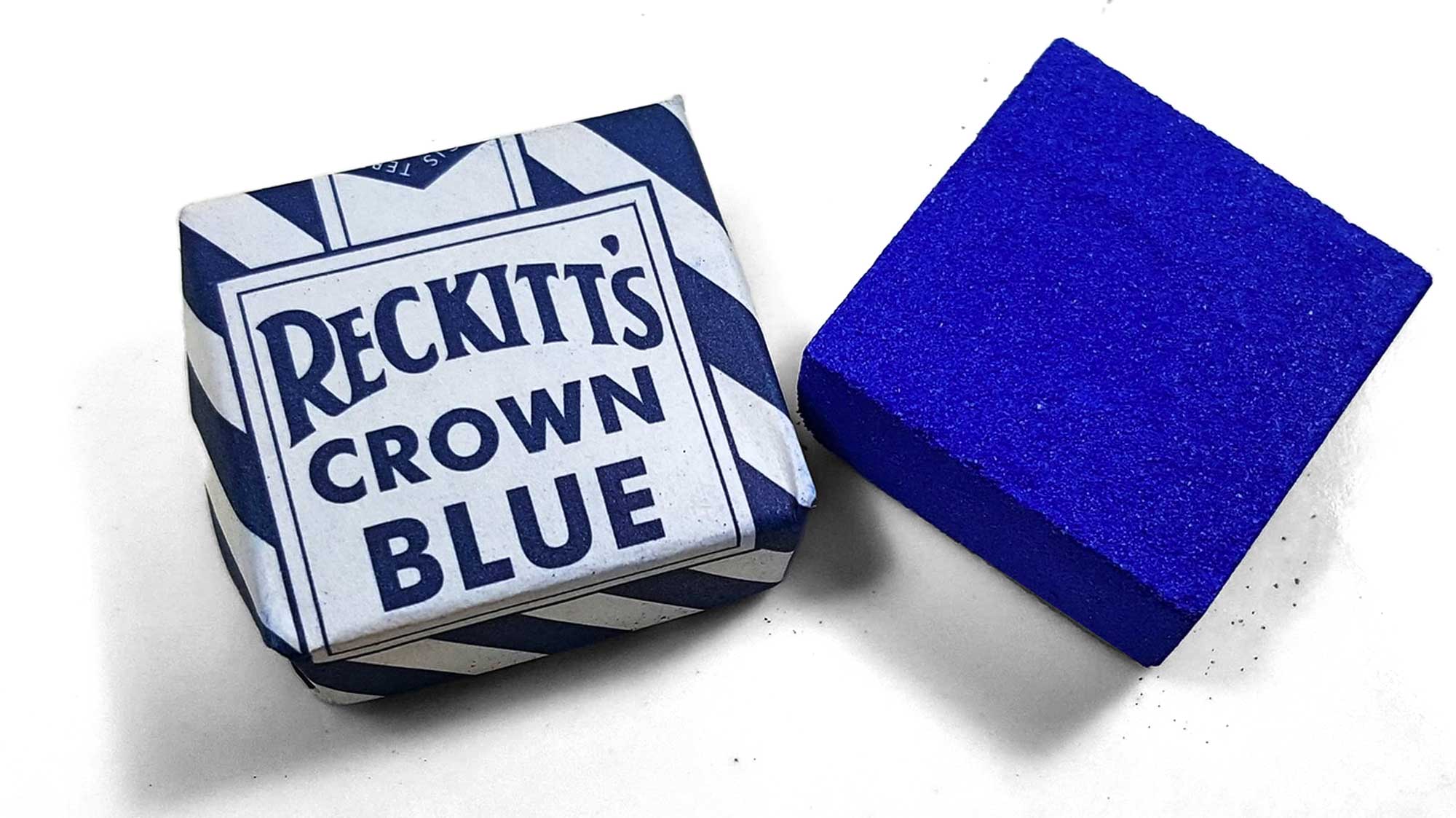
Explore the development and impact of ultramarine blue pigment, tracing its origins from lapis lazuli to its synthetic alternatives. This article offers insights into the historical significance, production processes, and economic factors surrounding this pigment. It addresses both its historical applications and its role in modern art, providing a comprehensive overview for artists, historians, and enthusiasts. Through examining the transition from natural to synthetic forms, readers gain a deeper understanding of ultramarine blue's enduring value in the artistic world.
What is Ultramarine Blue
Ultramarine is a blue pigment consisting primarily of a zeolite-based mineral containing small amounts of sulfur. Ultramarine is one of the most complex of the mineral pigments, composed of the blue mineral lazurite, which is the major component of the rare and semi-precious stone lapis lazuli. (Eastaugh, 2004) The mineral occurs in nature as a product of limestone metamorphism. It is typically associated with calcite, pyrite, diopside, humite, forsterite, hauyne, and muscovite minerals, sometimes found in lava as a by-product of volcanic eruptions. (Schumann, 2008)
The Complex Composition of Ultramarine Blue
Ultramarine pigments are sodium aluminum silicates of the composition Na8Al6Si6O24.Sx(Na-rich) or Na, _yAl6_ySi6+yO.Sx (Si-rich). Small sulfur-containing anions (e.g., S3 or S2) are bound as chromospheres in the interstices of the crystal lattice. Depending on the composition, blue, red, green, or violet pigments can be obtained, the hue being altered by varying the amount of silica. (Weldon, 2009) Ultramarine pigments have high heat resistance, but their universal use in paint is limited because of their poor hiding power and weather resistance. Special ultramarine pigments are coated with silica to reduce ultramarine’s susceptibility to acid and improve its weather resistance.
Synthetic ultramarine is a more vivid blue than natural ultramarine because the particles of synthetic ultramarine are more finely divided and uniform and contain fewer impurities than natural ultramarine or lapis lazuli. (Eastaugh, 2004)
Origin of the Name “Ultramarine”
The name derives from the Middle Latin ultramarinus, literally “beyond the sea,” because it was imported from Asia by sea. (Etymology) In the past, it has also been known as azzurrum ultramarine, azzurrum transmarinum, azzuro oltramarino, azur d'Acre, pierre d'azur, Lazurstein. Current terminology for ultramarine include natural ultramarine (English), outremer lapis (French), Ultramarin echt (German), oltremare genuino (Italian), and ultramarino verdadero (Spanish). The first recorded use of ultramarine as a color name in English was in 1598. (Maerz, 1930)
Before the nineteenth century, the word ultramarine designated the pigment derived from natural lazurite. After the mid-nineteenth century, it signified the synthetic analog of the mineral lazurite. Today, natural ultramarine is distinguished by the names lapis lazuli, lazurite, or genuine ultramarine.
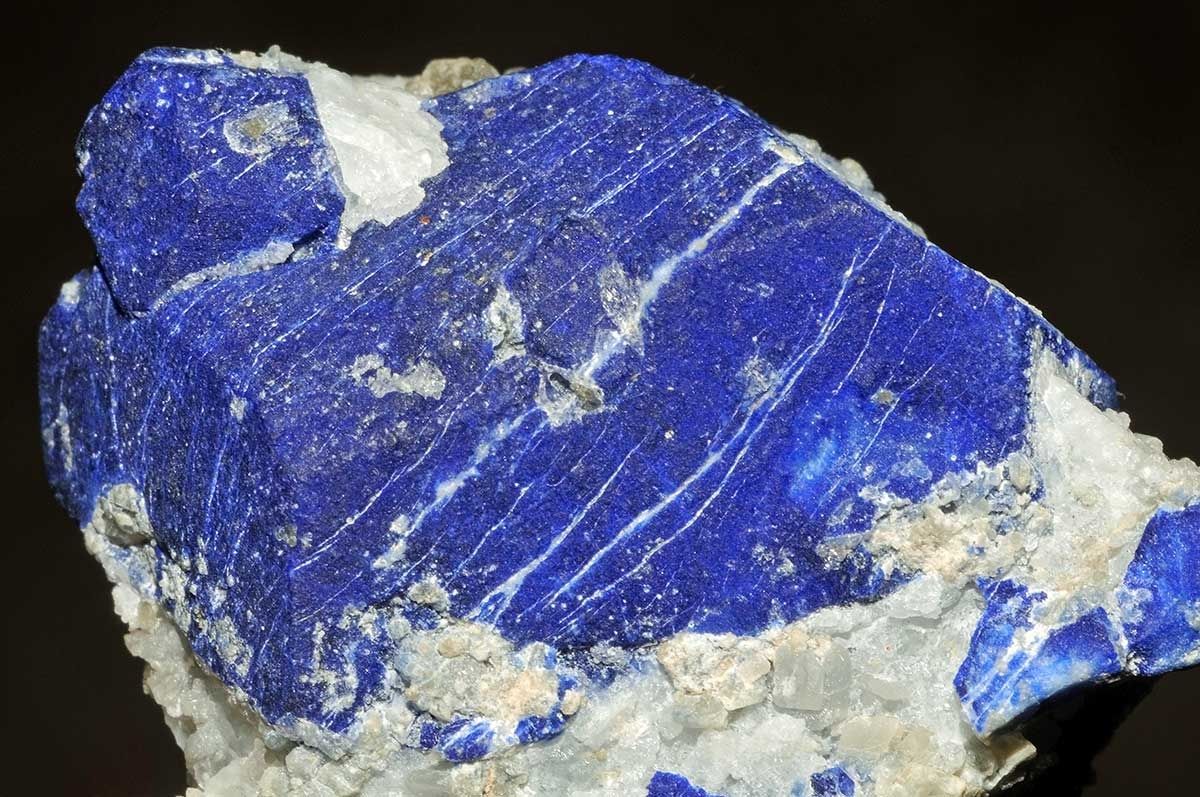
A specimen of lapis lazuli that has a high content of lazurite, the blue-colored mineral in the stone.
The History Of Ultramarine Blue
Lapis lazuli has been mined for centuries from a location still in use in the mountain valley of Kokcha, Afghanistan. First mined 6,000 years ago, the rock was transported to Egypt and later to Europe, where it was used in jewelry and paint.
The pigment was used most extensively during the fourteenth through sixteenth centuries, as its brilliance complemented vermilion in Italian panel paintings. It was valued chiefly because of its brilliancy of tone and its inertness to light exposure, oil, and lime. It is, however, extremely susceptible to dilute mineral acids.
European artists used the pigment sparingly, reserving their highest-quality blues for the robes of Mary and Christ. As a result of its high price, artists sometimes economized by using a cheaper blue, such as azurite, for the underpainting.
The rising demand for ultramarine eventually led to the development of artificial ultramarine. In 1814, Tassaert observed the formation of a blue compound similar to ultramarine, if not identical to it, in a lime kiln at Saint Gobain, which caused the Societé pour l’Encouragement d’Industrie to offer, in 1824, a prize for the artificial production of the precious color. Processes were devised by Jean Baptiste Guimet (1826) and by Christian Gmelin (1828), then professor of chemistry in Tübingen; but while Guimet kept his process a secret, Gmelin published his and was awarded the prize.
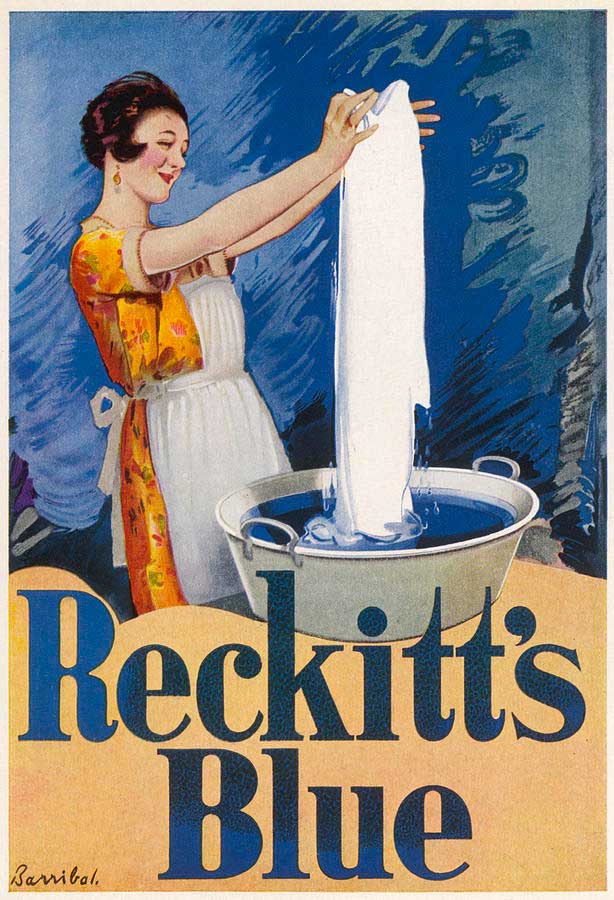
After its commercial introduction, synthetic ultramarine was an inexpensive pigment used in many consumer products, such as laundry soap, a process known as ‘laundry bluing.’ Laundry bluing was used from the late 18th to the mid-19th century. Reckitt’s Blue, introduced in the 1850s, contained synthetic ultramarine blue. It was sold as a powder, block, or coated on paper.
 |
 |
| Natural ultramarine blue (laps lazuli) in partial cross-polarized microscope enlarged 64 times. | Synthetic ultramarine blue in cross-polarized microscope enlarged 64 times. |
Production of Natural and Synthetic Ultramarine Blue Pigment
Natural Ultramarine
Natural ultramarine is a problematic pigment to grind by hand, and grinding and washing only produce a pale blue powder except for the highest quality mineral. The coarser pieces of lapis lazuli are pulverized, heated to redness, and immediately dipped into water, then very finely ground. The natural ultramarine powder was sometimes treated with dilute acetic acid to eliminate calcium carbonate.
At some point in the late medieval period, a method came into use, described by the fifteenth-century artist Cennino Cennini, that produced a deeper blue pigment. After grinding the mineral to a fine powder, it was next well incorporated with a mixture of equal parts of resin, wax, linseed oil, and Burgundy pitch. The resulting mass was wrapped in a cloth and then kneaded in a dilute lye solution. The blue particles dispersed into the lye solution, while the impurities remained in the mass. This process was repeated, with each successive extraction generating a lower-quality pigment. The final extraction, consisting primarily of colorless material and a few blue particles, resulted in ultramarine ash prized for its grayish-blue transparent hue. The quantity of genuine ultramarine obtained by this process amounts to two to three percent.
Synthetic Ultramarine
Gmelin first made synthetic ultramarine on a very small scale in 1822, but not before 1828 was ultramarine industrially obtained by Guimet at Lyons. In Germany, the first manufacturers of ultramarine were established at Wermelskirchen, in 1836, by Dr. Leverkuss, and at Nuremberg, in 1838, by M. M. Zeltner and Leykauf. France and Germany are the countries where this industry was most developed.
The raw materials used to make synthetic ultramarine are (1) iron-free alumina silicate, kaolin, or some other kind of pure china clay; (2) anhydrous sodium sulfate (Na2SO4); (3) anhydrous sodium carbonate (Na2CO3); (4) sulfur; and (5) finely-ground charcoal or relatively ash-free coal. (von Wagner, 1872)
Kaolin is generally used, or white clay, the composition of which contains silica and alumina as nearly as possible in the proportion of SiO2:Al2O3 demanded by the formula assigned to ideal kaolin. Small quantities of calcium and magnesium carbonate do not appear to have an adverse effect, but iron oxide should not exceed one percent. The composition of the clay should approach as nearly as possible to the formula Si2O7Al2; the silica may be combined or partly free. The clay is washed with water and treated in the same manner as for making porcelain; it is next dried, calcined, and ground to a very fine powder.
The raw materials are mixed well and placed in a reverberatory furnace. The result is the formation of a green substance, which absorbs oxygen very rapidly so that during the cooling of the mass in the oven, the majority converts to blue ultramarine.
How Ultramarine Blue Paint is Made
Optimum color is obtained from a paint in which the pigment is present as primary particles rather than larger agglomerates. Artificial ultramarine pigments range in primary particle size from one to five microns. It would not be easy to handle a dry powder comprising such fine particles, but as supplied by manufacturers, the pigment is in the form of larger soft agglomerates. These agglomerates must be broken down into the binding medium in a process called ‘dispersion.’
As supplied by the pigment manufacturer, ultramarine pigment particles are surrounded by air. To disperse the pigment, this air must be displaced by the medium, whether it is water, oil, or resin. This process is called ‘wetting,’ and various additives (dispersants) are used to improve the ultramarine's compatibility with the medium it is being dispersed. Ultramarine pigments are ‘hydrophilic,’ meaning they are most compatible with aqueous mediums. Ultramarine pigments disperse pretty quickly in the majority of oleophilic (literally, “oil loving”) mediums; however, pigment manufacturers produce a range of ultramarine pigments with an oleophilic surface coating (Holiday). Ultramarine pigments are often coated with alkyl and polyethylene glycols to maximize wetting in non-polar binding mediums, such as oils (Gelest).
Until the development of dispersants in the twentieth century, other ingredients were added to oil paints to help wet and deflocculate pigments. Unrefined vegetable oils with a high lecithin content were typically used as wetting agents. Other natural products of lower or high molecular weight (cashew nut liquid, rosin, gum arabic, milk and egg proteins, and natural resins) also contributed to pigment stabilization. Shortly after introducing synthetic pigments, additives (metal soaps and other fatty acid derivatives) were used to disperse pigments (Forio, 2004).
The hydrophilic property of ultramarine pigments causes poor wetting of its particles, resulting in stiff paste that ‘slumps’ after some time by flowing and leveling out when mixed with vegetable oils, such as linseed. Adding small amounts (15–25%) of linseed oil paint, poppy, or walnut oil can reduce the stringiness and add a buttery consistency to ultramarine. Oils with high free fatty acid content also improve wetting and reduce the slumping effect when grinding the pigment in oil.
The Compatibility and Lightfastness of Ultramarine Blue Pigment
Ultramarine exhibits excellent lightfastness and resistance to alkalis but is affected by dilute mineral acids. In certain conditions, the color has been noted to fade, a condition known as ‘ultramarine sickness.’ As paint ages, it can become brittle and powdery due to the degradation of the binding medium, which is often referred to as ‘chalking.’ The patchy whitening of ultramarine paints, or ultramarine sickness, is believed to be caused by the disintegration of the binding medium, while the ultramarine particles themselves remain unchanged. The binding medium around the pigment particles in the paint scatter the light, causing the paint surface to appear patchy and whitish. This is a characteristic of oil paint since ultramarine is mostly well preserved in waterborne tempera. Poor wetting of the pigment particles by the oil contributes to ultramarine sickness. Under acidic conditions, ultramarine pigment particles have been known to lose their colors due to the loss of sulfur, but this is only in the case of fresco paintings or paintings outdoors (Stoner, 2013).
Where to Buy
|
Oil Paints |
Pigments |
|
|
|
|
|
|
|
|
|
Natural Ultramarine (Lapis Lazuli) Blue Specifications
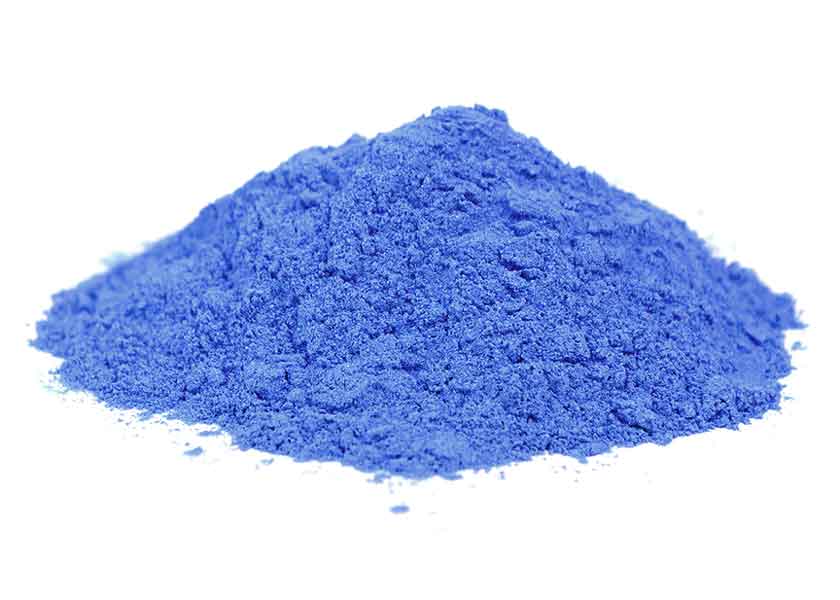

Natural ulltramarine blue (lapis lazuli) pigment
| Pigment Names | |||||||
| Common Names (rock): | English: lapis lazuli French: lapis-lazuli German: Lapislazuli Italian: lapislazzuli Spanish: lapislázuli |
||||||
| Common Names (mineral): | English: lazurite French: lazurite German: Lazurit Italian: lasurite Spanish: lazurite |
||||||
| Common Names (pigment): | English: ultramarine (natural) French: outremer (lapis) German: ultramarin (lapis) Italian: ultramarino (geuino) Spanish: ultramarino (lapis) |
||||||
| Alternate Names: | lapis lazuli blau, lasurstein blau, bleu d'azur | ||||||
| Nomenclature: |
|
||||||
| Pigment Information | |
| Color: | Blue |
| Pigment Classification: | Natural Inorganic |
| Colour Index: | Pigment Blue 29 (77007) (for synthetic ultramarine) |
| Chemical Name: | Sodium Calcium Aluminum Silicate Sulfate |
| Chemical Formula: | (Na, Ca)8Al6Si6O24(S, SO4) |
| CAS No.: | 1302-83-6 |
| Series No.: | 7 |
| ASTM Lightfastness | |
| Acrylic: | I |
| Oil: | I |
| Watercolor: | I |
| Physical Properties | |
| Particle Size (mean): | 12 microns |
| Density: | 2.70–2.90 g/cm3 |
| Hardness: | 5.0–5.5 |
| Refractive Index: | 1.50–1.55 |
| Oil Absorption: | 25 grams oil / 100 grams pigment |
| Health and Safety | No acute or known chronic health hazards are associated with this product's anticipated use (most chemicals are not thoroughly tested for chronic toxicity). Protect yourself against potentially unknown chronic hazards of this and other chemical products by keeping them out of your body. Do this by avoiding ingestion, excessive skin contact, and inhaling spraying mists, sanding dust, and vapors from heating. Conforms to ASTM D-4236. |
Natural Ultramarine (Lapis Lazuli) Blue Oil Paint Specifications
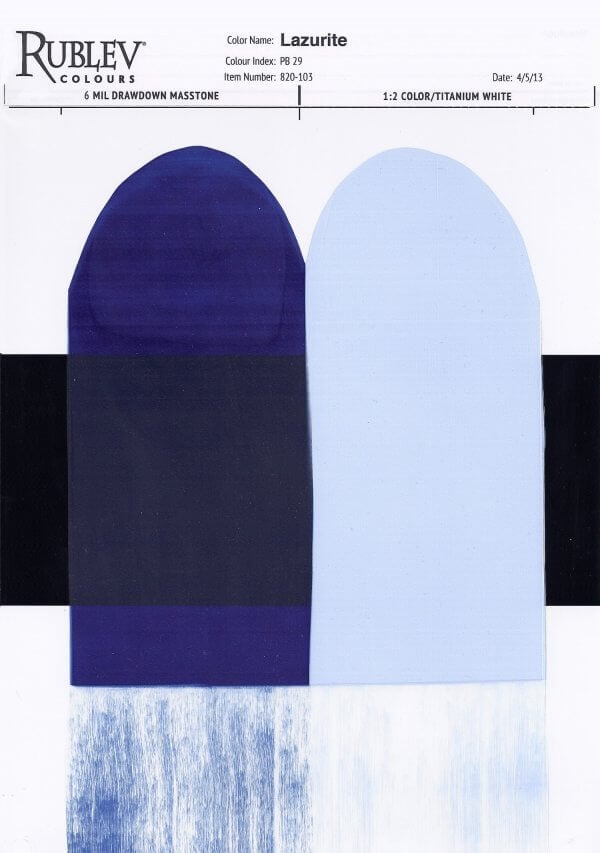

The image at right is a ‘drawdown’ of Rublev Colours Lazurite oil paint. The left drawdown is the full strength color at six mils (0.006 inches) thickness over a black and white opacity chart. The right drawdown is one part of the color mixed with two parts of titanium white. The bottom edges of the drawdowns were scraped to show the color of the undertone.
Composition and Permanence
| Lazurite | |
| Color: | Blue |
| Binder: | Linseed oil |
| Additive(s): | None |
| Pigment Information | |
| Pigment: | Lazurite |
| Pigment Classification: | Natural inorganic |
| Colour Index: | Pigment Blue 29 (77007) |
| Chemical Name: | Sodium Calcium Aluminum Silicate Sulfate |
| Chemical Formula: | (Na,Ca)8Al6Si6O24(S, SO4) |
| CAS No. | – |
| Properties | |
| Code: | 103 |
| Series: | 9 |
| Opacity: | Transparent |
| Tinting Strength: | Medium |
| Drying Rate: | Medium |
| Lightfastness: | Not Listed |
| Permanence: | A - 3 |
| Safety Information: | Based on a toxicological review, there are no acute or known chronic health hazards with the anticipated use of this product. Always protect yourself against potentially unknown chronic hazards of this and other chemical products by avoiding ingestion, excessive skin contact, and inhaling spraying mists, sanding dust, and concentrated vapors. Contact us for further information or consult the MSDS for more information. |
Ultramarine Blue (Green Shade) Oil Paint Specifications
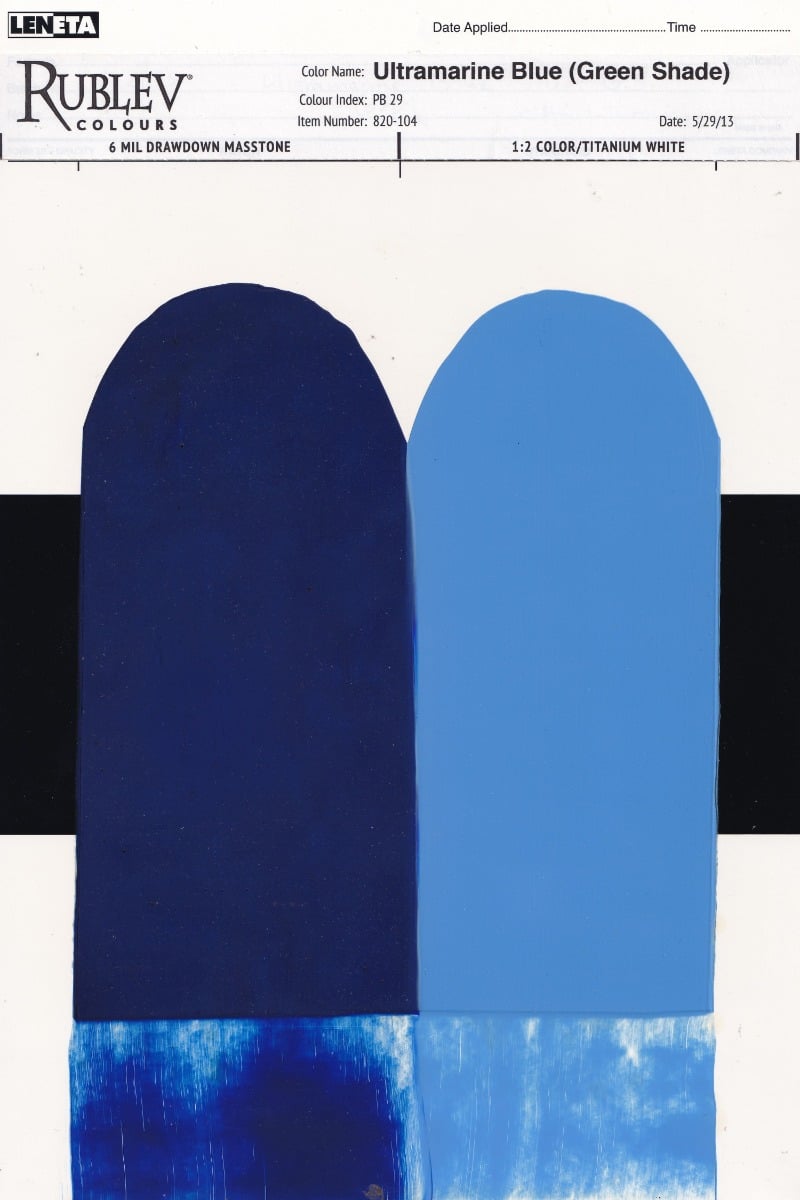

Composition and Permanence
| Ultramarine Blue (Green Shade) | |
| Color: | Blue |
| Binder: | Linseed oil |
| Additive(s): | None |
| Pigment Information | |
| Pigment: | Ultramarine Blue (Green Shade) |
| Pigment Classification: | Synthetic inorganic |
| Colour Index: | Pigment Blue 29 (77007) |
| Chemical Name: | Sodium Calcium Aluminum Silicate Sulfate |
| Chemical Formula: | (Na,Ca)8Al6Si6O24(S, SO4) |
| CAS No. | 57455-37-5 |
| Properties | |
| Code: | 104 |
| Series: | 2 |
| Opacity: | Transparent |
| Tinting Strength: | High |
| Drying Rate: | Medium |
| Lightfastness: | I |
| Permanence: | A - 3 |
| Safety Information: | Based on the toxicological review, there are no acute or known chronic health hazards with the anticipated use of this product. Always protect yourself against potentially unknown chronic hazards of this and other chemical products by avoiding ingestion, excessive skin contact, and inhaling spraying mists, sanding dust, and concentrated vapors. Contact us for further information or consult the MSDS for more information. |
Ultramarine Blue (Red Shade) Oil Paint Specifications
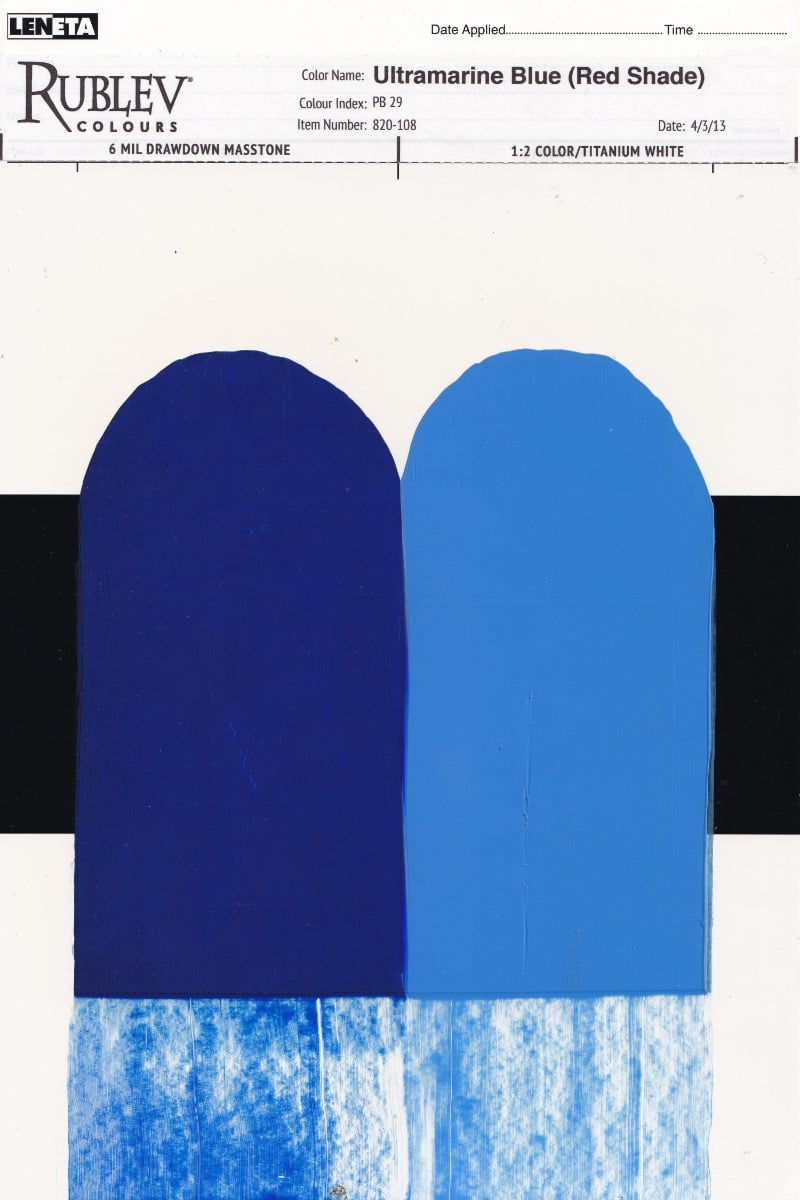

Composition and Permanence
| Ultramarine Blue (Green Shade) | |
| Color: | Blue |
| Binder: | Walnut oil |
| Additive(s): | None |
| Pigment Information | |
| Pigment: | Ultramarine Blue (Red Shade) |
| Pigment Classification: | Synthetic inorganic |
| Colour Index: | Pigment Blue 29 (77007) |
| Chemical Name: | Sodium Calcium Aluminum Silicate Sulfate |
| Chemical Formula: | (Na, Ca)8Al6Si6O24(S, SO4) |
| CAS No. | 57455-37-5 |
| Properties | |
| Code: | 105 |
| Series: | 2 |
| Opacity: | Transparent |
| Tinting Strength: | High |
| Drying Rate: | Medium |
| Lightfastness: | I |
| Permanence: | A - 3 |
| Safety Information: | Based on the toxicological review, there are no acute or known chronic health hazards with the anticipated use of this product. Always protect yourself against potentially unknown chronic hazards of this and other chemical products by avoiding ingestion, excessive skin contact, and inhaling spraying mists, sanding dust, and concentrated vapors. Contact us for further information or consult the MSDS for more information. |
References
(Eastaugh, 2004) Eastaugh, Nicholas, et al., 2004, The Pigment Compendium: Optical Microscopy of Historical Pigments. Oxford: Elsevier Butterworth-Heinemann, p. 219, ISBN 0-7506-4553-9.
(Schumann, 2008) Schumann, Walter, 2008, Minerals of the World. New York: Sterling, p. 216, ISBN 978-1-4027-5339-8.
(Weldon, 2009) Weldon, Dwight G., 2009, Failure Analysis of Paints and Coatings, p. 41.
(Eastaugh, 2004) )Eastaugh, Nicholas, 2004, Pigment Compendium: Optical Microscopy of Historical Pigments. Taylor & Francis, p. 45.
(Etymology) “ultramarine.” Online Etymology Dictionary. Retrieved: June 6, 2013.
(Maerz, 1930) Maerz, Aloys John, and Paul, Morris Rea, 1930, A Dictionary of Color. New York: McGraw Hill, p. 206.
(von Wagner, 1872) von Wagner, Johann Rudolph, 1872, A Handbook of Chemical Technology. Sir William Crookes, translator, and editor, p. 264–267.
(Holiday) Dispersion of Ultramarine Pigments. Holliday Pigments. Retrieved: June 6, 2013.
(Gelest) ML Surface Modification. Gelest. Retrieved: June 9, 2013.
(Forio, 2004) Florio, John J.; Miller, Daniel J., 2004, Handbook of Coatings Additives, p. 549.
(Stoner, 2013) Stoner, Joyce Hill, 2013, Conservation of Easel Paintings, p. 226.
See also Patton, Temple C., 1973, Pigment Handbook: Properties and Economics, Volume 1. New York: Wiley-Interscience, p. 410–415.
Frequently Asked Questions
Is lapis lazuli still used in paint?
Yes, lapis lazuli is still used in making high-quality artist's paints, especially for its unique deep blue hue, known as ultramarine blue. Its rarity and the intricate process required to create the pigment contribute to its continued value and use.
How do you make lapis lazuli paint?
Lapis lazuli paint is made by grinding the lapis lazuli stone into a fine powder and then mixing it with a binding agent, such as linseed oil for oil paint or gum arabic for watercolors. This process preserves the vibrant blue color of the pigment.
How do you mix lapis lazuli color?
To mimic the color of lapis lazuli in paint, mix ultramarine blue with a small amount of white. Adjust the ratios to achieve the desired shade of deep, vibrant blue characteristic of lapis lazuli.
Is lapis lazuli purple or blue?
Lapis lazuli is primarily blue, often with a rich, deep azure or ultramarine quality. Natural variations can include flecks of white calcite or pyrite, which may add a slight golden sheen, but the predominant color of lapis lazuli is blue.
How do you make blue lapis lazuli?
Blue lapis lazuli is a natural stone that is not made but mined and processed. The stone is extracted from lapis lazuli deposits, primarily found in Afghanistan, and then carefully cut, polished, and sometimes ground into powder for pigment.












